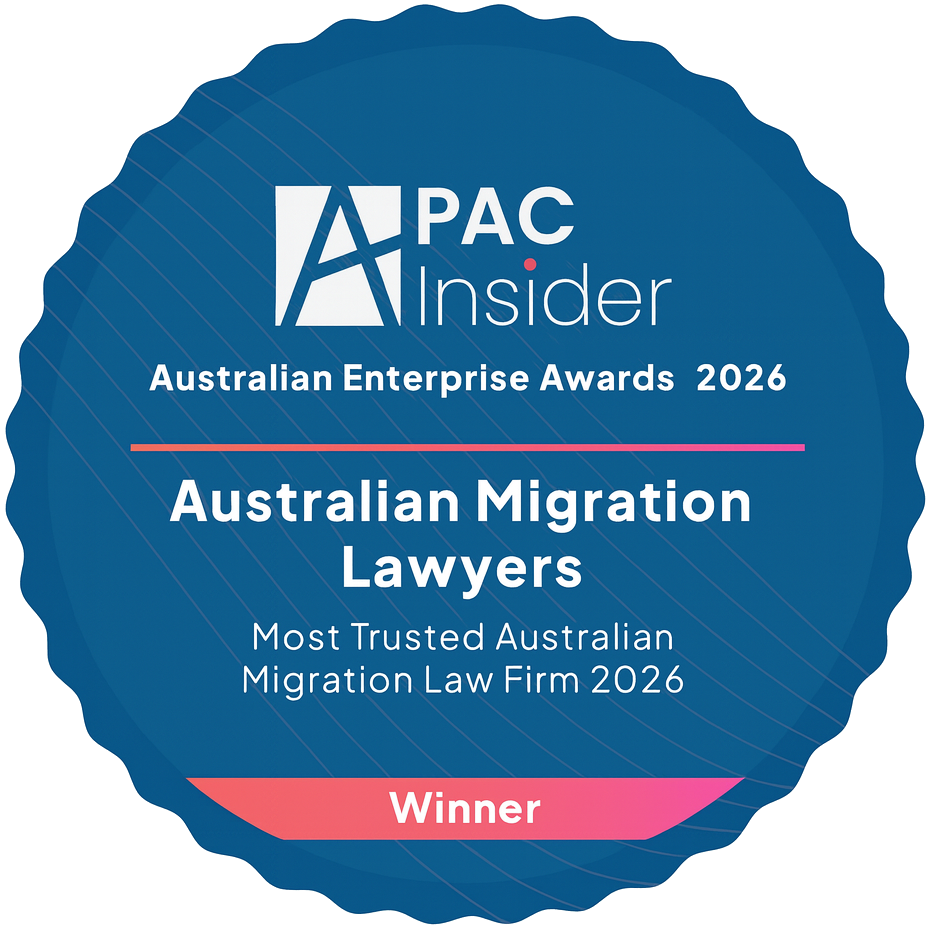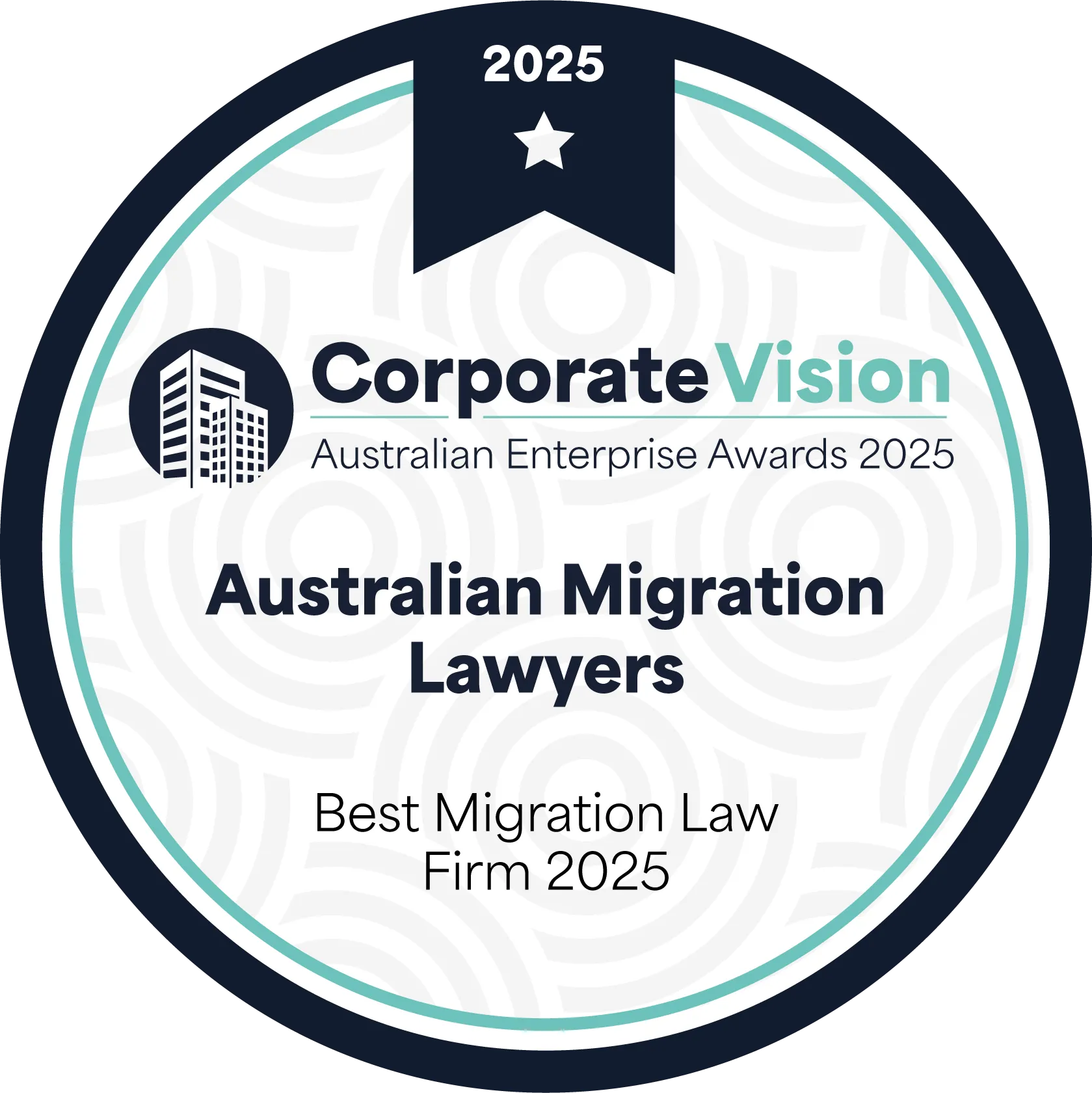Australia's largest independent migration law firm. Open 7 days! Book here.
Need help? We are available 7 days a week.

.webp)

Winner of Most Trusted Australian Migration Law Firm 2023-2026

Ranked 1st for migration law in 2023, 2024 & 2025

Ranked in the top migration lawyers 2023, 2024 & 2025

Ranked the best migration law firm 2024 & 2025
%20(1).webp)
Recognizing the importance of global connections, the Australian Government allows citizens/residents to sponsor their partners through Partner visas for temporary or permanent residency in Australia, providing stability and continuity to your relationship. While applying for a Partner visa can be time-consuming and complex, Australian Migration Lawyers offer expertise in navigating the process efficiently.
A Partner visa allows an Australian Citizen or permanent resident (or eligible New Zealand resident) to sponsor their spouse or de-facto partner to migrate to Australia, initially for two years with the possibility of permanent residence thereafter. Different visa subclasses apply depending on whether the applicant is onshore or offshore. Upon visa approval, the applicant gains unrestricted rights to live, work, study, and travel, with permanent residency granting full benefits and entitlements. Determining the appropriate subclass is the first step, with subclass 820/801 for onshore applicants, subclass 309/100 for offshore applicants, and subclass 300 for Prospective Marriage visas, each with unique processes and eligibility criteria.
For the Onshore Partner Visa (Subclass 820/801), eligibility criteria include being in Australia at the time of application, being in a genuine relationship with an Australian partner (citizen, permanent resident, or eligible New Zealand citizen), and meeting age, health, and character requirements.
The Offshore Partner Visa (Subclass 309/100) requires applicants to be sponsored by their Australian partner, have a genuine relationship, and meet health, character, and age criteria. Additionally, applicants must have met their partner in person at least once and be outside Australia when applying for the visa.
The Prospective Marriage Visa (Subclass 300) necessitates offshore application, a face-to-face meeting with the prospective spouse, intention to marry within the visa period, and meeting health, character, and age requirements. As sponsors, individuals must provide financial and accommodation support, accept responsibility for debts, obligations, and compliance with Australian laws, and submit a Notice of Intended Marriage.
The key differences between each type of partner visa are:
Onshore Partner Visa (Subclass 820):
Offshore Partner Visa (Subclass 309):
Prospective Marriage Visa (Subclass 300):
The choice between these visas depends on the applicant's circumstances, including whether they are already in Australia, their relationship status, and their future plans regarding marriage and residency. Each option offers distinct benefits and requirements tailored to different relationship situations.
The process for applying for all types of Partner visas follows a similar pattern:
Initial Consultation and Engagement:
Schedule a consultation with one of our lawyers to discuss your situation and determine which visa subclass you qualify for. Meetings can be arranged in person, via Zoom, or over the phone. After the consultation, we will provide you with paperwork confirming our engagement to represent you.
Preparation and Support:
We will guide you on the specific documents needed for your application and assist you in preparing them. Our team will draft written submissions supporting your visa application, tailored to your circumstances and backed by appropriate evidence.
Submission and Communication:
Your application will be submitted to the relevant authority (Department of Home Affairs, courts, or tribunal), and we will keep you updated on its status.
Representation and Success:
We will keep you informed throughout the application process and notify you of the outcome. If your application is unsuccessful and there's an option to reapply, we will assist you. Alternatively, our lawyers are well-equipped to appeal the decision to the tribunal or courts if necessary.
[free_consultation]Book a consultation[/free_consultation]
The current fee for the Australian Department of Home Affairs for Partner visas is outlined in the table below (payable at the time of lodgment). This fee must be paid in full upfront, as the Department does not accept split payments. Payment methods accepted include debit/credit card, PayPal, UnionPay, and BPAY. Unfortunately, this fee is non-refundable in the event of application refusal or rejection. Thus, ensuring a strong application is essential. For visa subclasses 309/100 (offshore) and 820/801 (onshore), the initial fee covers both the temporary visa and permanent residence. Therefore, no additional payment is required for permanent residency after the base fee is paid. For visa subclass 300, the fee for the Permanent Partner visa application is reduced rather than waived. Learn mroe about partner visa costs in Australia.
[table]
[thead]
[tr]
[th]Visa Subclass [/th]
[th]Main Applicant fee (AUD)[/th]
[th]Additional Applicant 18+ (AUD)[/th]
[th]Addtional Applicant <18 (AUD)[/th]
[/tr]
[/thead]
[tbody]
[tr]
[td]Subclass 309/100 (Offshore); Subclass 820/801 (Onshore); Subclass 300 (Prospective Marriage).[/td]
[td]$9,365[/td]
[td]$4,685[/td]
[td]$2,345[/td]
[/tr]
[tr]
[td]Subclass 820/801 application by Subclass 300 visa holders (Prospective Marriage)[/td]
[td]$9,365[/td]
[td]$4,685[/td]
[td]$2,345[/td]
[/tr]
[tr]
[td]Prospective marriage[/td]
[td]$9,365[/td]
[td]$4,685[/td]
[td]$2,345[/td]
[/tbody]
[/table]
Any costs that may be incurred by the applicant prior to submissions may be related to service fees of migration agents or lawyers where clients are required to have their consultations and meetings paid prior to lodgement.
Sponsors are entrusted with significant obligations upon signing the sponsorship form, a requisite document submitted alongside the applicant's partner or fiancé visa application. Whether sponsoring a fiancé visa or a prospective marriage visa, sponsors assume sole responsibility for the financial commitments their partners may incur during their stay in Australia. This necessitates a thorough assessment by the Department of Immigration, evaluating sponsors' employment and financial circumstances.
Upon visa approval, sponsors are obligated to furnish adequate accommodation and financial support to meet their partner's living needs. These obligations encompass reasonable living requirements and extend over the initial two years of the partner's stay in Australia, whether the application is lodged offshore or onshore. Consequently, sponsors must ensure provision for their partner from the temporary partner visa grant until the permanent partner visa is secured, typically spanning a two-year period.
In support of the sponsorship undertaking, sponsors should furnish documentary evidence substantiating their capability to fulfill accommodation and financial assistance obligations. Furthermore, if the partner's application encompasses secondary applicants, sponsors are accountable for extending their support to all secondary applicants as well. Therefore, sponsors must assess their capacity to provide support not only for their partner but also for any additional secondary applicants included in the visa application.
[aml_difference][/aml_difference]
The primary challenge leading to visa refusal often arises from the Department's perception that the relationship lacks genuineness and mutual commitment. Even if the relationship is genuine, insufficient evidence may fail to meet the Department's criteria. Evaluation of genuineness encompasses the financial, social, living arrangements, and commitment aspects of the relationship. While it's advisable to provide evidence for each criterion, the Department assesses them collectively. This guide aims to clarify the necessary evidence for each criterion to prevent refusal.
Another common challenge in visa processing is the variability in processing times, influenced by factors both within and beyond applicants' control. Applicants can enhance their chances by submitting comprehensive applications with credible evidence, responding promptly to requests for further information, and aiming for "decision-ready" submissions. However, factors like country of passport can lead to significant differences in processing times, potentially resulting in discrimination against certain nationalities. Additionally, disparities in obtaining visitor visas may affect eligibility for onshore partner visas, particularly for applicants from certain regions. Despite these challenges, professional support can help navigate the process efficiently and ensure fair consideration under the law for all applicants.
Upon the grant of Partner visas in Australia, recipients are bestowed with certain rights and obligations under Australian law. Through the Visa Entitlement Verification Online (VEVO) system, visa holders can easily access their visa status and associated conditions. Here's an overview of the entitlements and responsibilities outlined by the Department of Home Affairs:
For the Prospective Marriage visa (Subclass 300), this temporary visa permits recipients to stay in Australia for 9 to 15 months from the date of grant, with authorization to work and study in Australia, and multiple entries to and exits from the country during the validity of the visa.
The Temporary Partner visa (Subclass 820 and 301) offers temporary residence, work, and study rights in Australia, along with access to free English language classes if eligible, eligibility to apply for Medicare, and permission to bring a family member.
For the Permanent Partner visa (Subclass 801 and 100), this permanent visa provides permanent residency in Australia, full work and study rights, access to Medicare and social security benefits, sponsorship rights for family members (contingent upon meeting visa conditions and complying with Australian laws), and multiple entries to and exits from Australia for five years from the visa grant date.
Engaging skilled Australian Migration Lawyers specializing in partner visa applications streamlines the process, providing personalized support and ensuring adherence to immigration regulations. Comprehensive understanding of visa prerequisites, meticulous compilation of required documents, and timely attendance at interviews are pivotal. Prompt response to any immigration authority requests for further information is imperative. Remaining informed about policy updates and seeking guidance from reputable sources are equally vital. By adhering to these guidelines and seeking legal aid, applicants can confidently and efficiently navigate the administrative journey.
[aus_wide_service][/aus_wide_service]

We have created comprehensive visa guides that outline the ins and outs of visa applications. Get yours today.